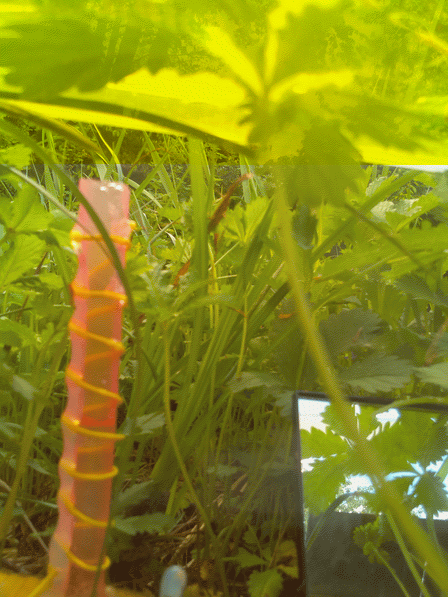In the last blog entry i declared WaterFeeler2 pretty much dead. A few days ago, i went so far as to release a YouTube video with updates for the next project, in which i also stated i would turn WaterFeeler2 off in a few days.
After that, i tried to get one last image out of the probe... and it worked! By timing it right, i could get the PanCam to power up, take an image and download (most of) it. There's still a bit of the blue channel missing in the top part of the image (making it very green), but it looks like i could still do limited daytime operation:

"Uhm, we seem to have landed on a jungle planet? Oh wait, it's one of them `small - far away` thingies"
So, the only instrument that is completely broken is the rain sensor. DHT (digital temperature and humidity) sensors still work. The soil humidity sensor still works (even though the data itself is crap due to its very low sensitivity). And even the camera works.
The one gripe i have is the inaccuracy of the analog inputs of the Arduino, especially under low voltage condition. I'm currently preparing a new Arduino firmware to try and use the internal 1.1V voltage reference as the calibration source. I'm not sure when i can upload this, i'll need at least a couple of hours of direct sunlight on the panels to run the PanCam/Raspberry Pi. First i need to upload the hex file, then i'll download it to verify. If everything checks out, i can send the "flash" command, and then start testing out the new code.
Looking at the weather forecast, this will probably be a multi-day operation.
You may ask why i still update the firmware for a nearly dead probe. Well, the reason is rather simple: It's a good test bed for operating probes in low/unstable power situations. While many of the future missions will work from the new, central solar station with it's ample power (still challenging during winter when snow is on the panels), there will be probes and rovers with their own, independant power supply. These will still have small solar panels and small lead acid batteries, all controlled by a crappy (but small and lightweight) PWM charger.
And yes, i'm still going with lead acid batteries. They are so much nicer to work with that lithiums with their tendency for rapid unplanned exothermic disassembly. Meaning, i prefer not to have tiny napalm bombs all over my garden.
I will keep you updated, things are moving very fast at the moment.
|





